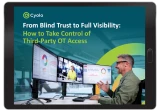Table of Contents
- How Industrial Cybersecurity Got a Bad Reputation
- Secure Remote Access: From Security Guard to Growth Engine
- Why UX Can Make or Break an SRA Solution
- Rethinking Access for Third Parties vs. Internal Teams
- AI is Improving Access (Without Taking Over)
- It’s More Than ‘Just’ Cybersecurity – It’s a Business Advantage
How Industrial Cybersecurity Got a Bad Reputation
For years, cybersecurity has been seen largely as a roadblock in manufacturing and other critical industries.
This is at least partly because OT environments simply weren’t built with security in mind. They were designed to be isolated. Air-gapped. Closed off from the outside world. And as long as everything stayed on-site and hermetically sealed, the risk of a breach or other security incident stayed low.
But then came a revolutionary shift: more digital integration, more remote access, more third-party vendors. Suddenly, connectivity in manufacturing was considered essential – and therefore so was cybersecurity.
In many if not most cases, early security tools added friction. Solutions created for IT settings adapted poorly to OT environments, leading to user frustration, operational delays and even safety risks – and giving rise to the notion that security inhibits efficiency and productivity.
And this depiction of cybersecurity as a blocker has persisted, even as emerging security solutions have actually allowed industrial organizations to work in new and more efficient ways.
Secure remote access (SRA) is a perfect example. Many companies adopted SRA out of pure necessity during the covid pandemic. But it gradually became clear that enabling remote work has widespread benefits, many of which contribute directly to the bottom line.
A new report from Takepoint Research (TPR) and Cyolo explores how manufacturers are changing their perspective on SRA, from a barrier to a business accelerator.
Now let’s talk about why.
Secure Remote Access: From Security Guard to Growth Engine
The TPR/Cyolo study, based on a survey of 535 qualified manufacturing professionals across North America and EMEA – including CISOs, OT security leads, and operations managers – found that SRA isn’t just protecting businesses. It’s powering them.
64% use SRA to enable real-time access to critical systems
67% cited improved third-party collaboration as the biggest benefit of implementing SRA
58% reported higher operational efficiency and productivity
50% have experienced cost savings
These responses reveal the degree to which SRA is helping to keep plants running, supply chains moving, and teams collaborating across borders and time zones.
Why UX Can Make or Break an SRA Solution
Despite widespread adoption and high satisfaction with secure remote access in general, many manufacturers are markedly less enthusiastic about the specific SRA tools they currently have deployed.
Less than 7% are “very satisfied” with the effectiveness of SRA measures now in place, and the average user experience (UX) rating is just 2.5 out of 5.
Translation: most access solutions still feel like they were built by someone who’s never set foot in a plant, let alone designed with operators or engineers in mind.
If your users need seven different logins and a degree in portal navigation just to access a programmable logic controller (PLC), guess what happens? They’ll find a workaround. And chances are, that workaround will bypass security altogether.
But better UX changes that. 66% of survey respondents said improved UX boosts productivity. And 57% linked it to stronger compliance.
Bottom line: the best security tool is the one people actually use. And tools that are easy to use are built with UX in mind from the start.
When access is simple and intuitive with good UX, it increases adoption across the board, supporting smoother operations and reinforcing security policies. Making it a direct path to better performance and measurable business value.
That value becomes even more apparent when we look at who actually has access permissions – and who doesn’t.
Rethinking Access for Third Parties vs. Internal Teams
According to the report, a staggering 88% of manufacturers allow remote third-party access to OT systems. 60% grant such access to over 100 external vendors, OEMs, and contractors.
Why?
Because third parties and OEMs keep operations running (and keep warranties from being voided). Because flying out support engineers for a ten-minute fix no longer makes business sense. And because remote diagnostics and support have become the new norm.
Yet in a surprising twist, only 54% authorize internal employees to remotely access OT environments. So while a huge majority of companies are comfortable opening the door to outsiders, they’re less likely to offer remote access as an option for their own employees.
This gap suggests a reactive approach: grant access when forced, not when there’s potential to create value.
Why not reframe SRA as a proactive, strategic tool, giving internal teams the same flexibility and operational agility that external partners already enjoy? The result will be even quicker fixes, smoother workflows, and a stronger case for attracting and retaining top technical talent.
AI is Improving Access (Without Taking Over)
SRA isn’t just about connection – it’s increasingly about intelligence. And AI is now officially in the mix.
96% of surveyed manufacturers are using or plan to use AI to strengthen SRA
61% cite threat detection and response as the biggest area of AI impact
47% believe AI will improve compliance and risk management
38% say AI helps flag issues before they escalate
This isn’t ‘AI-will-solve-everything’ hype. It’s about adding AI capabilities where they can provide practical, tangible gains. Cyolo PRO (Privileged Remote Operations) with Intelligent Supervision, for instance, eases heavy admin burdens without removing human oversight.
AI won’t (and shouldn't) replace your security team – but it can be a valuable assistant. When integrated effectively, AI boosts visibility, speeds up insights, and scales operations without bottlenecks for stronger plant performance and greater resilience.
It’s More Than ‘Just’ Cybersecurity – It’s a Business Advantage
The numbers are in.
Secure remote access is no longer just a safety net – it’s a springboard.
In manufacturing and other critical industries, the right SRA strategy can help teams move faster with quicker diagnostics. It makes third-party access manageable instead of messy. It improves everyone’s daily workflow, from the control room to the C-suite.
And it lays the foundation for achieving long-term business goals without added complexity or overhead.
When designed for real-world environments and situations, SRA doesn’t just close security gaps – it opens up new business opportunities.
Download the full report to see how leading manufacturers are using SRA to move forward faster, smarter, and more securely.
Can Cybersecurity Drive Growth?
Discover the strategic role of Secure Remote Access in manufacturing

Jennifer Tullman-Botzer
Author
Jennifer Tullman-Botzer has over a decade of experience in cybersecurity marketing and is as tired as you are of hackers-in-hoodies stock images. She joined Cyolo in 2021 and currently serves as Head of Content. Prior to Cyolo, Jennifer worked in a variety of marketing roles at IBM Security. She lives in Tel Aviv, Israel.

Subscribe to Our Newsletter







